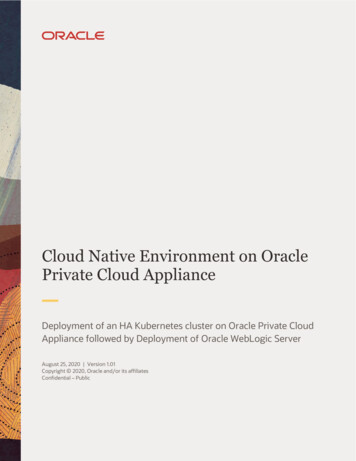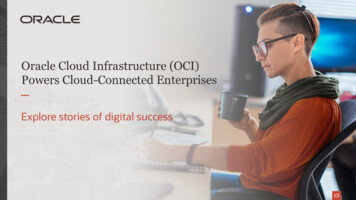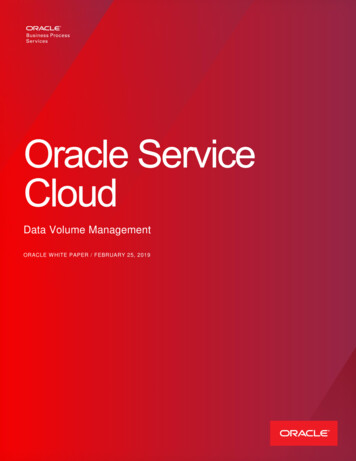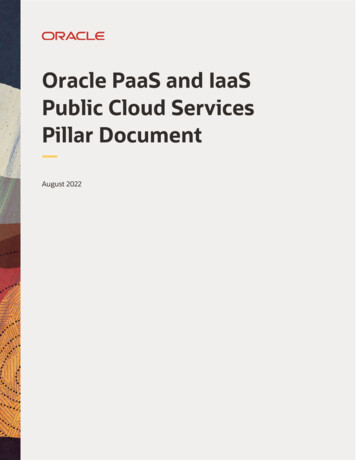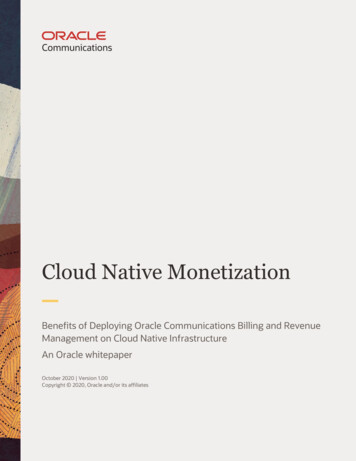
Transcription
Cloud Native MonetizationBenefits of Deploying Oracle Communications Billing and RevenueManagement on Cloud Native InfrastructureAn Oracle whitepaperOctober 2020 Version 1.00Copyright 2020, Oracle and/or its affiliates
SAFE HARBOR STATEMENTThe following is intended to outline our general product direction. It is intended for information purposes only, and may notbe incorporated into any contract. It is not a commitment to deliver any material, code, or functionality, and should not berelied upon in making purchasing decisions. The development, release, timing, and pricing of any features or functionalitydescribed for Oracle’s products may change and remains at the sole discretion of Oracle Corporation.This document is provided for information purposes and should not be relied upon in making a purchasing decision. Thecontents hereof are subject to change without notice. This document is not warranted to be error-free, nor subject to anyother warranties or conditions, whether expressed orally or implied in law, including implied warranties and conditions ofmerchantability or fitness for a particular purpose.THIS DOCUMENT IS NOT PART OF A LICENSE AGREEMENT NOR CAN IT BE INCORPORATED INTO ANY CONTRACTUALAGREEMENT WITH ORACLE CORPORATION OR ITS SUBSIDIARIES OR AFFILIATES.Failure to adhere to these benchmarks does not constitute a breach of Oracle s obligations. We specifically disclaim anyliability with respect to this document and no contractual obligations are formed either directly or indirectly by thisdocument.1WHITE PAPER Cloud Native Monetization Version 1.00Copyright 2020, Oracle and/or its affiliates
TABLE OF CONTENTSSafe Harbor Statement1Introduction3The Importance of Cloud Native Monetization3Oracle Communications Billing and Revenue Management (BRM)3Deploying BRM on Cloud Native Infrastructure5The Features and Extensibility of BRM, the Agility and Efficiency of Cloud Native5BRM Multi Service Architecture6Example Cloud Native Deployment topology in Oracle Cloud Infrastructure (OCI)7BRM Cloud Native BenefitsDeployment BenefitsFaster InstallationOperational BenefitsEnvironment ion Changes10Batch Job Invocation10Logging and Regular Operational Benefits11Efficient Scalability11Self-Healing11Future Upgrades12Time To Market Benefits12Summary13Glossary of terms142WHITE PAPER Cloud Native Monetization Version 1.00Copyright 2020, Oracle and/or its affiliates
INTRODUCTIONThe Importance of Cloud Native MonetizationModern monetization systems for 5G converged charging, communications, media, cloud and digital goods and servicesmarkets will need to take optimal advantage of compute, network, and storage infrastructure to operate and scale efficientlyand grow as the business demands. These requirements translate into the need for monetization systems to support a cloudnative containerized, orchestrated and multi-service deployment architecture. Diving a little deeper into these terms: Containerized – portable, lightweight application components that can be rapidly spun-up and down, takingadvantage of core Linux kernel capabilities (namespaces and control groups) that are much more efficient thanHypervisor-based virtualization technologies.Orchestrated – managing the lifecycle of the multiple containers that comprise the application by abstracting theunderlying infrastructure and providing built-in scalability and resiliency through the definition of a declared stateof deployment that is maintained by the orchestration engine. Container orchestration technology enables simplerapplication management and dramatically reduces operational complexity.Multi-service – an architecture where application components representing specific functional concerns aredeployed in separate containers to aid scalability, resiliency, and observability. Core business functions should bedeployed as multi-replica containers.The above-mentioned cloud native characteristics will be essential to take advantage of today’s DevOps aligned ContinuousIntegration/Continuous Delivery (CI/CD) toolchains. This will help to minimize time-to-value, scale efficiently, and improvethe overall operational quality of deployments. Some business benefits of cloud native deployment include: Significantly reduced vanilla installation timeRapid environment replication for development, testing and faster root cause analysis of potential issuesSelf-healing capabilities for greater service availabilitySimpler updates with less downtimeEfficient scaling that takes maximum advantage of the available compute resources (nodes)Faster launch of reliable market offerings by taking advantage of CI/CD toolchain integration and automationOracle Communications Billing and Revenue Management (BRM)Oracle Communications Billing and Revenue Management (BRM) is a proven, reliable, modern monetization solution that isfoundational to the digital commerce operations of leading telecommunications and enterprise customers. BRM providesconverged, real-time charging as part of an end-to-end revenue management solution for supporting the key businessprocesses of generation, capture, collection, and analysis of revenue. Flexible service, industry and partner-enabled business model support.Faster innovation: rapidly launch digital offers with design-time flexibility.IT agility: modern cloud native deployment model with low total cost of ownership.Figure 1 – BRM feature coverage3WHITE PAPER Cloud Native Monetization Version 1.00Copyright 2020, Oracle and/or its affiliates
Oracle Converged Charging SystemBRM Release 12 has been designed with the 5G future in mind supporting the 5G service-based architecture while offering afeature rich converged charging, billing and revenue management system that is both network grade and extensible (figure1). BRM provides a foundation for monetizing 5G Non-Standalone Architecture based services and Standalone Architectureslice-based offerings, available in a DevOps aligned cloud native deployment model to significantly reduce costs andaccelerate innovationBRM’s Elastic Charging Engine (or ECE) is an advanced, network grade and high performance in memory convergedcharging grid with built-in resilience. It includes a comprehensive set of southbound core network integration pointsincluding support for Diameter and the 3GPP 5G HTTP/2 REST charging message, as well as flexible offline mediationcapabilities.ECE is integrated into the core BRM revenue management functionality (shown in the upper half of the diagram) whichprovides flexible and extensible business logic across customer management, service management, subscriptionmanagement, re-rating, billing, invoicing and accounts receivable.The high-level functional architecture is shown in figure 2. Shown in the lower half of this diagram we have BRM’sconverged charging capabilities, supporting integrated online and offline charging in a single architecture.Figure 2 – BRM Functional ArchitectureBRM exposes a large number of functions with a documented SDK to aid integration into northbound enterprise businesssystems. Integration methods include web services and via the BRM JCA resource Adapter. In addition, BRM has datamanagers supporting integration with external taxation databases and payment processing systems.Supporting the core functionality, BRM has a comprehensive set of client applications covering operations andadministration, customer management and offer design.4WHITE PAPER Cloud Native Monetization Version 1.00Copyright 2020, Oracle and/or its affiliates
DEPLOYING BRM ON CLOUD NATIVE INFRASTRUCTUREThe Features and Extensibility of BRM, the Agility and Efficiency of Cloud NativeBRM can be configured to run as a cloud native application in a containerized and orchestrated deployment architecture,taking advantage of cloud native infrastructure and DevOps CI/CD tooling to enable service providers to design, test anddeploy services more quickly, operate more efficiently, and grow with the business (figure 3).Figure 3 – BRM Cloud Native container images uses standard cloud native techologiesBRM has a multi service architecture with each service provided as a Docker image for deploying as a run time container in aKubernetes cluster on cloud infrastructure. This deployment option takes advantage of industry accepted cloud nativetechnologies such as Docker for the container runtime, Kubernetes for container orchestration, Helm for packaging anddeployment, and the EFK stack, comprising of ElasticSearch, fluentd and Kibana for logging. BRM’s cloud native deploymentretains the features and extensibility of BRM whilst taking advantage of the agility and efficiency of cloud nativeinfrastructure and tooling.A high level logical view of BRM’s cloud native deployment option is shown in figure 4 below.Figure 4 – BRM Cloud Native deployment high level logical view5WHITE PAPER Cloud Native Monetization Version 1.00Copyright 2020, Oracle and/or its affiliates
BRM Multi Service ArchitectureFigure 5 shows BRM’s multi-service architecture. Each BRM service, running as a Docker container, is deployed as aKubernetes POD, the fundamental building block of Kubernetes. Many of the core BRM services can be deployed andmanaged as multiple replicas within a Kubernetes replica set, which enables efficient scaling and aids resiliency. Kubernetesoperates on the principle of declared state – you tell it how many instances of a POD you want running and it will ensure thatthe number of replicas matches the declared state.Figure 5 – BRM Cloud Native Multi-Service ArchitectureThe BRM application Kubernetes cluster requires that cloud native infrastructure and tooling is in place. This includes cloudcompute infrastructure, such as Oracle Cloud Infrastructure (OCI), a CI/CD automation pipeline, monitoring and loggingsoftware, Kubernetes cluster networking and volume storage, which is accessed by PODs via a persistent volume claim(PVC). Note that the Oracle database sits outside of the BRM application Kubernetes cluster, typically deployed in a separatesubnet.6WHITE PAPER Cloud Native Monetization Version 1.00Copyright 2020, Oracle and/or its affiliates
Example Cloud Native Deployment topology in Oracle Cloud Infrastructure (OCI)Cloud native BRM has been designed to be deployed in both public and private cloud infrastructure. An exampledeployment model is shown in figure 7, which shows BRM deployed in Oracle Cloud Infrastructure (OCI). Note that not alldetails are shown in this diagram and it is intended to be for illustrative purposes only, rather than represent a specificdeployment architecture. Deployment approaches will be dependent upon specific business requirements. For deploymentin OCI, it is recommended to configure BRM application worker nodes in three different fault domains (FDs) within anAvailability Domain (AD). The diagram shows an Oracle RAC cluster in a dedicated subnet, using Active Data Guard forreplication with a secondary database in another AD, depending upon business requirements. From an ECE perspective,Coherence federation is used to ensure that the charging grid cache is replicated to a secondary availability domain (notshown).Figure 7 – Example BRM Cloud Native OCI Deployment ModelA bastion host is typically configured in a public subnet to allow access to the BRM worker nodes from the customer’s network(for example via SSH). The BRM web clients and inbound integrations connect to the load balancer through the Internetgateway. Outbound integrations, for example payment or taxation server integration, are managed through the NAT gateway,which is also used by the worker nodes for outbound access to the Internet (for example to perform yum updates).7WHITE PAPER Cloud Native Monetization Version 1.00Copyright 2020, Oracle and/or its affiliates
BRM CLOUD NATIVE BENEFITSCloud native deployment of BRM has the potential to provide significant benefits with regards to initial deployment, ongoingoperations and reduced time to market to launch and monetize new products and services. This section provides a highlevel summary of these benefits. It is important to understand that the degree of savings depends on specific deploymentarchitecture, workload, degree of product customization and overall adoption of DevOps CI/CD and cloud native toolingacross the service provider’s broader IT estate. Figure 8 summarizes indicative deployment and operational efficiencies ofcloud native BRM when compared to a traditional BRM deployment model.Figure 8 – Indicative operational savings compared to traditional on-premise BRM deployment*Deployment BenefitsFaster InstallationThe initial deployment time for BRM in a cloud native environment is significantly reduced through the use of Helm (thepackage manager for Kubernetes applications). A separate Helm chart is provided for the database schema deploymentflexibility for those customers that already have a database in place. Helm unifies the installation experience, eliminating theneed for customers to manually download software technology dependencies, such as compilers, the JDK, and Perl scriptsto a compute server. The reduction in installation steps can provide significant time and cost savings for customers whensetting up test and production environments.Table 3 describes the Helm charts that are included in the BRM cloud native deployment package.HELM s and upgrades the database schema for the BRM server functions.oc-cn-op-job-helm-chartCreates WebLogic server domains for Billing Care and Business Operations Center (BOC).oc-cn-helm-chartDeploys the core BRM server components, Pricing Design Center (PDC) and PipelineConfiguration Center (PCC).oc-cn-ece-helm-chartDeploys the Elastic Charging Engine (ECE) and its services. Sets the connection with the BRMserver functions and Pricing Design Center. Configures the sharing of persistent volumes with theBRM server functions.Table 3 – Helm Charts included in the BRM cloud native deployment package8WHITE PAPER Cloud Native Monetization Version 1.00Copyright 2020, Oracle and/or its affiliates
From the perspective of BRM’s Elastic Charging Engine (ECE), cloud native deployment simplifies the Coherence clusterdeployment, eliminating the need for customers to define the primary and secondary driver machines, sync softwarebinaries across the server nodes or VMs and configure the cluster topology (in eceTopology.conf).The customer would define the number of replicas by overriding the default values from values.yaml with adding customvalues in override-values.yaml and then run the Helm install, which ensures that all components are started in sequenceand places the system into a usage processing state.ECE high availability is configured by default, with each Elastic Charging Server node consisting of three POD replicas andeach protocol gateway node consisting of 2 POD replicas.BRM’s WebLogic applications, such as Pricing Design Center (PDC), Billing Care (BC) and Business Operations Center (BOC)are significantly faster to install as WebLogic is already baked into the base Docker images.Based on indicative Oracle lab metrics, and assuming the readiness of underlying cloud native infrastructure and thedatabase, vanilla BRM application installation time could be significantly reduced by approximately 60%.Operational BenefitsEnvironment ReplicationOnce initial deployment has taken place, separate environments can be rapidly replicated by simply overriding the Helmconfiguration with environment specific values in the values.yaml override file and performing a Helm install. This is arapid process that can offer significant savings, particularly to those customers that require large numbers of environmentsto be spun up within their DevOps CI/CD processes.Rapid environment replication can also have significant benefits to aid root cause analysis of any potential issues observedin production, by replicating the production environment in a dev/test environment for rapid problem resolution throughinvestigation, patching and validation.Based on indicative Oracle lab metrics, BRM environment replication time could be reduced by as much as 65%,depending on the specific customer DevOps processes and toolchain adoption.CustomizationAs discussed earlier a key benefit of the BRM cloud native architecture is the ability to integrate into a service provider’sCI/CD workflow to support automated build, test and deployment processes. Figure 9 shows the high-level flow involvedwhen extending BRM through new customizations, showing Oracle Cloud Infrastructure as the continuous delivery anddeployment infrastructure. BRM’s cloud native deployment option supports BRM’s extensibility and customizationcapabilities. Custom C and Java code can be used to extend the core business logic capabilities, develop new clientapplications and extend the Billing Care UI.A customer or partner would take the base BRM images, store them in their registry of choice, and then create a new imagewith the customizations using Docker layering. After the build and test process these new images will be pushed to thecontainer registry for deployment into test and production under the co-ordination of the DevOps CI/CD pipeline tooling.Figure 9 – Customizing and extending BRM via CI/CD toolchain integration9WHITE PAPER Cloud Native Monetization Version 1.00Copyright 2020, Oracle and/or its affiliates
The time for customization bug detection, fixing, testing and deployment can be significantly reduced when deploying BRMalongside a CI/CD toolchain and supported by DevOps automation. It is anticipated that deploying BRM in an automatedcloud native environment could offer customization implementation efficiencies of 20% or greater.PatchingThe benefits of CI/CD automation significantly reduces the patching cycle (whether for bug fixes or security updates) frompatch updates on a dev and test environment, automated testing and validation, through to deployment to staging and finalproduction environments. Depending upon the nature of the patch (e.g. whether a one-off patch or patchset, degreeof data model changes etc), it is anticipated that the efficiency savings achieved for patching could be as high as50%.Patchset UpgradesPatchset upgrades in a BRM cloud native deployment are faster and more efficient. The upgrade process consists of runningthe init db container in upgrade mode, which performs the database schema upgrade, and then perform a Helm upgradewith the new set of images. During the upgrade, the same port and IP (via the Kubernetes service proxy) continues to servicerequests.For ECE, Kubernetes will take care of rolling restart of the ECE pods and each pod will automatically check the Coherencecluster status to make sure partition rebalancing is complete during the restart.Configuration ChangesCore BRM business logic configuration changes are very straightforward and require near zero service downtime as a rollingupgrade of the BRM server-side components is possible.Each BRM application service has its configuration externalized via a Helm chart and Kubernetes ConfigMaps. Externalizedconfiguration is an important characteristic of cloud native applications, decoupling the Docker images from theconfiguration (which can be stored in a version control system). Kubernetes makes rolling out (and rolling back) newconfiguration changes easy through the use of Helm, which creates and updates deployments and services (figure 10).Figure 10 – Near zero downtime configuration changesFor example, changes in the BRM pin.conf file can be achieved by invoking helm upgrade specifying the updatedoverride-values.yaml file. Similarly, after invoking changes in config business params for example, by running helmupgrade, the new PODs will read their configuration from the database with no overall service loss due to the rolling upgradeprocess supported by Kubernetes.Whenever a BRM ConfigMap or Secret file is changed, BRM supports the configuration of a POD to automatically update itsdeployment specification and hence support a rolling deployment. This is achieved via the use of annotations in theKubernetes deployment YAML descriptor.A business logic configuration change that would have typically needed a system restart is now supported by a rollingupdate of the CM or DM, providing near zero BRM ecosystem downtime.Batch Job InvocationKubernetes jobs are provided for key revenue management batch applications, such as billing jobs, invoicing, andimport/export pricing utilities, making configuration and invocation efficient and straightforward, and adhering to cloudnative best practices by avoiding the need to exec into the POD containers to directly run the jobs.10WHITE PAPER Cloud Native Monetization Version 1.00Copyright 2020, Oracle and/or its affiliates
Logging and Regular Operational BenefitsThe use of industry standard cloud native tooling provides improved efficiency for regular day to day BRM operations toensure smooth running of the system. For example, all BRM PODs use the ElasticSearch, Fluentd and Kibana stack forcentralized logging and visualization (figure 11).Figure 11 – BRM cloud native logging environment using the EFK stackEach fluentd agent pod is deployed within a Kubernetes DaemonSet, which deploys one pod for each node in the BRMapplication cluster. The BRM application PODs write logs to stdout, which are collected by fluentd and persists them intothe ElasticSearch object store, ready for visualization by Kibana.Efficient ScalabilityA key principle of cloud native applications is the ability to efficiently scale multiple service instances, whether that is “up” tosupport new capacity demands for example charging operations during busy seasons or “down” to free up capacity whencertain applications are not required to be running (for example for communications service providers, billing and invoicingjobs may only be required to be run during certain periods in a month).The core BRM business logic services, for example the connection managers and data managers, are multi-replica(managed by a ReplicaSet). Load balancing across multiple CMs and DMs is inherent and is maintained by the Kubernetesservice proxy, which abstracts the client service requests from the specific instances of the backend serving PODs. Thisprovides significant efficiency improvements when load sharing multiple CMs and DMs across workloads. Figure 12illustrates the efficient scaling of BRM’s multi-replica PODs. The number of desired replica’s can be specified viaconfiguration, with Kubernetes perfoming scaling to meet this state. From the command line business logic replicas can bescaled with the command:kubectl scale deployment/cm – replicas 4Changing the number of replicas will create or shutdown pods without client disruption.Figure 12 – Efficient BRM business logic scalability using Kubernetes replicasSelf-HealingKubernetes is inherently self-healing, always operating on the principle of declared state and ensuring the correct number ofPOD replicas are running. The BRM business logic and data management services will gracefully terminate if Kubernetesdecides to reduce the number of running PODs.11WHITE PAPER Cloud Native Monetization Version 1.00Copyright 2020, Oracle and/or its affiliates
Future UpgradesIt is anticipated that deploying BRM in a cloud native environment could offer future upgrade efficiencies of 20% orgreater, depending on the specific deployment context and project scope (for example the degree of customization) andthe extent to which cloud native and DevOps is embraced.Future minor and major upgrades will follow the same high-level process as described previously for patchset upgrades(specific times and upgrade process details will be release specific).Time To Market BenefitsDeployment of BRM on cloud native infrastructure within a DevOps CI/CD toolchain can contribute to overall time to marketbenefits beyond the deployment, operational and upgrade savings described above. When deployed alongside anautomated DevOps toolchain and supporting business processes, and in combination with adoption across a serviceprovider’s broader IT estate, cloud native BRM can contribute to the faster launch of new services and resultant earlierrevenue generation. The combination of BRM’s inherent flexibility and extensible business logic with the efficiency gainsfrom a fully automated Continuous Integration/Continuous Deployment (CI/CD) toolchain and broader cloud native ITadoption across the enterprise, can shorten the time from concept to launch, which will be critical as we enter the “digitalnative” and 5G era.12WHITE PAPER Cloud Native Monetization Version 1.00Copyright 2020, Oracle and/or its affiliates
SUMMARYOracle Communications Billing and Revenue Management is a modern monetization solution that provides real timeconverged charging for any business model. It is available in a cloud native deployment option, supporting a Kubernetesorchestrated containerized multi-service architecture to facilitate continuous integration / continuous delivery and DevOpspractices. Best deployed on Oracle’s Cloud Infrastructure with its autonomous capabilities, adaptive intelligence andmachine learning cyber security, BRM cloud native has the option of being deployed in public or private cloud infrastructureenvironments that provide standard cloud native tooling and can support the Oracle database.BRM’s cloud native deployment option enables BRM to take advantage of the efficiencies of modern cloud computeinfrastructure and automated toolchains, supporting easier and faster installations, agile service development and launch,simplified configuration updates, rapid environment replication and efficient scaling. As a result, BRM can enable serviceproviders to design, test and deploy services faster, improve operational savings and scale with the business.Figure 13 – Summary of cloud native BRM Benefits13WHITE PAPER Cloud Native Monetization Version 1.00Copyright 2020, Oracle and/or its affiliates
GLOSSARY OF TERMSADAn Availability Domain in Oracle Cloud InfrastructureCI/CDContinuous Integration / Continuous DeliveryCMThe BRM Connection Manager serviceDMThe BRM Data Manager serviceECEBRM’s Elastic Charging EngineEFKElasticSearch, Fluentd, Kibana – a popular logging stackFDA Fault Domain in Oracle Cloud InfrastructureHelmA package and deployment manager for Kubernetes applicationsOCIOracle Cloud InfrastructurePODKubernetes deployment unitPVCPersistent Volume ClaimRACOracle Real Application ClustersCONNECT WITH USCall 1.800.ORACLE1 or visit oracle.com.Outside North America, find your local office at acletwitter.com/oracleCopyright 2020, Oracle and/or its affiliates. All rights reserved. This document is provided for information purposes only, and the contents hereof are subject to change withoutnotice. This document is not warranted to be error-free, nor subject to any other warranties or conditions, whether expressed orally or implied in law, including implied warrantiesand conditions of merchantability or fitness for a particular purpose. We specifically disclaim any liability with respect to this document, and no contractual obligations are formedeither directly or indirectly by this document. This document may not be reproduced or transmitted in any form or by any means, electronic or mechanical, for any purpose, withoutour prior written permission.Oracle and Java are registered trademarks of Oracle and/or its affiliates. Other names may be trademarks of their respective owners.Intel and Intel Xeon are trademarks or registered trademarks of Intel Corporation. All SPARC trademarks are used under license and are trademarks or registered trademarks ofSPARC International, Inc. AMD, Opteron, the AMD logo, and the AMD Opteron logo are trademarks or registered trademarks of Advanced Micro Devices. UNIX is a registeredtrademark of The Open Group. 1020Cloud Native MonetizationOctober, 2020Authors: Richard Hallett
Modern monetization systems for 5G converged charging, communications, media, cloud and digital goods and services markets will need to take optimal advantage of compute, network, and storage infrastructure to operate and scale efficiently . (CI/CD) toolchains. This will help to minimize time-to-value, scale efficiently, and improve

